#auschwitz
Text
This is what happens when we don’t teach people which books it was that the Nazis burned.
#far right#nonbinary#sapphic#lesbian#lgbt pride#lgbtq community#gay girls#nonbinary lesbian#queer#lgbtq#lgbtqia#extremism#liberalism#auschwitz#hypocrisy#trans#transfemme#trans pride#transgender#trans positivity#trans man#history#history lesson#world history#culture#tiktok#videos
10K notes
·
View notes
Text

This week, Lily Ebert, a 100-year-old Auschwitz survivor, became a great-great-grandma.
"I never expected to survive the Holocaust. Now I have five beautiful generations. The Nazis did not win!"
From near-death at Auschwitz to five generations of Jewish life. - Dov Forman
923 notes
·
View notes
Text
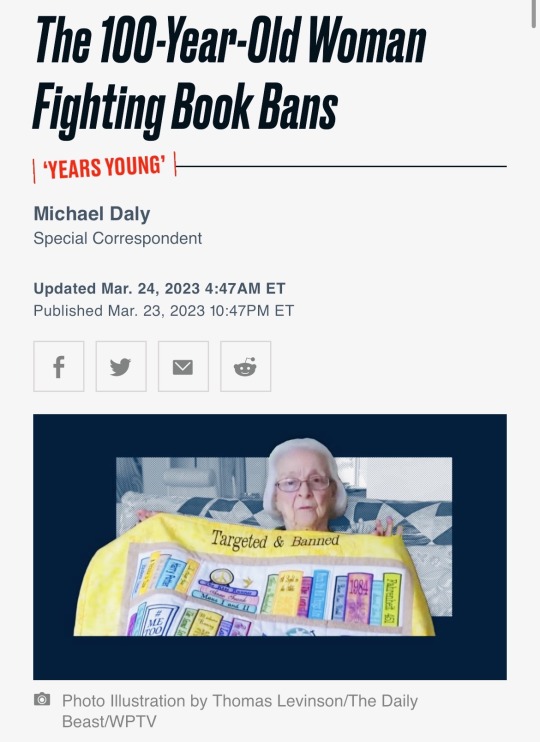

youtube




read the full article here
help fight book censorship
#i’m sorry (not sorry)- i swear this is the last one#i’m in near tears at work & i had to#grace linn#book banning#banned books#book censorship#libraries#public libraries#school libraries#censorship#florida#martin county#us politics#world war two#auschwitz
4K notes
·
View notes
Text
The long, bloody lineage of private equity's looting

Tomorrow (June 3) at 1:30PM, I’m in Edinburgh for the Cymera Festival on a panel with Nina Allen and Ian McDonald.
Monday (June 5) at 7:15PM, I’m in London at the British Library with my novel Red Team Blues, hosted by Baroness Martha Lane Fox.

Fans of the Sopranos will remember the “bust out” as a mob tactic in which a business is taken over, loaded up with debt, and driven into the ground, wrecking the lives of the business’s workers, customers and suppliers. When the mafia does this, we call it a bust out; when Wall Street does it, we call it “private equity.”
It used to be that we rarely heard about private equity, but then, as national chains and iconic companies started to vanish, this mysterious financial arrangement popped up with increasing frequency. When a finance bro’s presentation on why Olive Garden needed to be re-orged when viral, there was a lot off snickering about the decline of a tacky business whose value prop was unlimited carbs. But the bro was working for Starboard Value, a hedge fund that specialized in buhying out and killing off companies, pocketing billions while destroying profitable businesses.
https://www.salon.com/2014/09/17/the_real_olive_garden_scandal_why_greedy_hedge_funders_suddenly_care_so_much_about_breadsticks/
Starboard Value’s game was straightforward: buy a business, load it with debt, sell off its physical plant — the buildings it did business out of — pay itself, and then have the business lease back the buildings, bleeding out money until it collapsed. They pulled it with Red Lobster,and the point of the viral Olive Garden dis track was to soften up the company for its own bust out.
The bust out tactic wasn’t limited to mocking middlebrow family restaurants. For years, the crooks who ran these ops did a brisk trade in blaming the internet. Why did Sears tank? Everyone knows that the 19th century business was an antique, incapable of mounting a challenge in the age of e-commerce. That was a great smokescreen for an old-fashioned bust out that saw corporate looters make off with hundreds of millions, leaving behind empty storefronts and emptier pension accounts for the workers who built the wealth the looters stole:
https://prospect.org/economy/vulture-capitalism-killed-sears/
Same goes for Toys R Us: it wasn’t Amazon that killed the iconic toy retailer — it was the PE bosses who extracted $200m from the chain, then walked away, hands in pockets and whistling, while the businesses collapsed and the workers got zero severance:
https://www.washingtonpost.com/news/business/wp/2018/06/01/how-can-they-walk-away-with-millions-and-leave-workers-with-zero-toys-r-us-workers-say-they-deserve-severance/
It’s a good racket — for the racketeers. Private equity has grown from a finance sideshow to Wall Street’s apex predator, and it’s devouring the real economy through a string of audactious bust outs, each more consequential and depraved than the last.
As PE shows that it can turn profitable businesses gigantic windfalls, sticking the rest of us with the job of sorting out the smoking craters they leave behind, more and more investors are piling in. Today, the PE sector loves a rollup, which is when they buy several related businesses and merge them into one firm. The nominal business-case for a rollup is that the new, bigger firm is more “efficient.” In reality, a rollup’s strength is in eliminating competition. When all the pet groomers, or funeral homes, or urgent care clinics for ten miles share the same owner, they can raise prices, lower wages, and fuck over suppliers.
They can also borrow. A quirk of the credit markets is that a standalone small business is valued at about 3–5x its annual revenues. But if that business is part of a large firm, it is valued at 10–20x annual turnover. That means that when a private equity company rolls up a comedy club, ad agency or water bottler (all businesses presently experiencing PE rollup), with $1m in annual revenues, it shows up on the PE company’s balance sheet as an asset worth $10–20m. That’s $10–20m worth of collateral the PE fund can stake for loans that let it buy and roll up more small businesses.
2.9 million Boomer-owned businesses, employing 32m people, are expected to sell in the next couple years as their owners retire. Most of these businesses will sell to PE firms, who can afford to pay more for them as a prelude to a bust out than anyone intending to operate them as a productive business could ever pay:
https://pluralistic.net/2022/12/16/schumpeterian-terrorism/#deliberately-broken
PE’s most ghastly impact is felt in the health care sector. Whole towns’ worth of emergency rooms, family practices, labs and other health firms have been scooped up by PE, which has spent more than $1t since 2012 on health acquisitions:
https://pluralistic.net/2022/11/17/the-doctor-will-fleece-you-now/#pe-in-full-effect
Once a health care company is owned by PE, it is significantly more likely to commit medicare fraud. It also cuts wages and staffing for doctors and nurses. PE-owned facilities do more unnecessary and often dangerous procedures. Appointments get shorter. The companies get embroiled in kickback scandals. PE-backed dentists hack away at children’s mouths, filling them full of root-canals.
https://pluralistic.net/2022/11/17/the-doctor-will-fleece-you-now/#pe-in-full-effect
The Healthcare Private Equity Association boasts that its members are poised to spend more than $3t to create “the future of healthcare.”
https://hcpea.org/#!event-list
As bad as PE is for healthcare, it’s worse for long-term care. PE-owned nursing homes are charnel houses, and there’s a particularly nasty PE scam where elderly patients are tricked into signing up for palliative care, which is never delivered (and isn’t needed, because the patients aren’t dying!). These fake “hospices” get huge payouts from medicare — and the patient is made permanently ineligible for future medicare, because they are recorded being in their final decline:
https://pluralistic.net/2023/04/26/death-panels/#what-the-heck-is-going-on-with-CMS
Every part of the health care sector is being busted out by PE. Another ugly PE trick, the “club deal,” is devouring the medical supply business. Club deals were huge in the 2000s, destroying rent-controlled housing, energy companies, Mervyn’s department stores, Harrah’s, and Old Country Joe. Now it’s doing the same to medical supplies:
https://pluralistic.net/2021/05/14/billionaire-class-solidarity/#club-deals
Private equity is behind the mass rollup of single-family homes across America. Wall Street landlords are the worst landlords in America, who load up your rent with junk fees, leave your home in a state of dangerous disrepair, and evict you at the drop of a hat:
https://pluralistic.net/2021/08/16/die-miete-ist-zu-hoch/#assets-v-human-rights
As these houses decay through neglect, private equity makes a bundle from tenants and even more borrowing against the houses. In a few short years, much of America’s desperately undersupplied housing stock will be beyond repair. It’s a bust out.
You know all those exploding trains filled with dangerous chemicals that poison entire towns? Private equity bust outs:
https://pluralistic.net/2022/02/04/up-your-nose/#rail-barons
Where did PE come from? How can these people look themselves in the mirror? Why do we let them get away with it? How do we stop them?
Today in The American Prospect, Maureen Tkacik reviews two new books that try to answer all four of these questions, but really only manage to answer the first three:
https://prospect.org/culture/books/2023-06-02-days-of-plunder-morgenson-rosner-ballou-review/
The first of these books is These Are the Plunderers: How Private Equity Runs — and Wrecks — America by Gretchen Morgenson and Joshua Rosner:
https://www.simonandschuster.com/books/These-Are-the-Plunderers/Gretchen-Morgenson/9781982191283
The second is Plunder: Private Equity’s Plan to Pillage America, by Brendan Ballou:
https://www.hachettebookgroup.com/titles/brendan-ballou/plunder/9781541702103/
Both books describe the bust out from the inside. For example, PetSmart — looted for $30 billion by RaymondSvider and his PE fund BC Partners — is a slaughterhouse for animals. The company systematically neglects animals — failing to pay workers to come in and feed them, say, or refusing to provide backup power to run during power outages, letting animals freeze or roast to death. Though PetSmart has its own vet clinics, the company doesn’t want to pay its vets to nurse the animals it damages, so it denies them care. But the company is also too cheap to euthanize those animals, so it lets them starve to death. PetSmart is also too cheap to cremate the animals, so its traumatized staff are ordered to smuggle the dead, rotting animals into random dumpsters.
All this happened while PetSmart’s sales increased by 60%, matched by growth in the company’s gross margins. All that money went to the bust out.
https://www.forbes.com/sites/antoinegara/2021/09/27/the-30-billion-kitty-meet-the-investor-who-made-a-fortune-on-pet-food/
Tkacik says these books show that we’re finally getting wise to PE. Back in the Clinton years, the PE critique painted the perps as sharp operators who reduced quality and jacked up prices. Today, books like these paint these “investors” as the monsters they are — crooks whose bust ups are crimes, not clever finance hacks.
Take the Carlyle Group, which pioneered nursing home rollups. As Carlyle slashed wages, its workers suffered — but its elderly patients suffered more. Thousands of Carlyle “customers” died of “dehydration, gangrenous bedsores, and preventable falls” in the pre-covid years.
https://www.washingtonpost.com/business/economy/opioid-overdoses-bedsores-and-broken-bones-what-happened-when-a-private-equity-firm-sought-profits-in-caring-for-societys-most-vulnerable/2018/11/25/09089a4a-ed14-11e8-baac-2a674e91502b_story.html
KKR, another PE monster, bought a second-hand chain of homes for mentally disabled adults from another PE company, then squeezed it for the last drops of blood left in the corpse. KKR cut wages to $8/hour and increased shifts to 36 hours, then threatened to have workers who went home early arrested and charged with “patient abandonment.” Many of these homes were often left with no staff at all, with patients left to starve and stew in their own waste.
PE loves to pick on people who can’t fight back: kids, sick people, disabled people, old people. No surprise, then, that PE loves prisons — the ultimate captive audience. HIG Capital is a $55b fund that owns TKC Holdings, who got the contract to feed the prisoners at 400 institutions. They got the contract after the prisons fired Aramark, owned by PE giant Warburg Pincus, whose food was so inedible that it provoked riots. TKC got a million bucks extra to take over the food at Michigan’s Kinross Correctional Facility, then, incredibly, made the food worse. A chef who refused to serve 100 bags of rotten potatoes (“the most disgusting thing I’ve seen in my life”) was fired:
https://www.wzzm13.com/article/news/local/michigan/prison-food-worker-i-was-fired-for-refusing-to-serve-rotten-potatoes/69-467297770
TKC doesn’t just operate prison kitchens — it operates prison commissaries, where it gouges prisoners on junk food to replace the inedible slop it serves in the cafeteria. The prisoners buy this food with money they make working in the prison workshops, for $0.10–0.25/hour. Those workshops are also run by TKC.
Tkacic traces private equity back to the “corporate raiders” of the 1950s and 1960s, who “stealthily borrowed money to buy up enough shares in a small or midsized company to control its biggest bloc of votes, then force a stock swap and install himself as CEO.”
The most famous of these raiders was Eli Black, who took over United Fruit with this gambit — a company that had a long association with the CIA, who had obligingly toppled democratically elected governments and installed dictators friendly to United’s interests (this is where the term “banana republic” comes from).
Eli Black’s son is Leon Black, a notorious PE predator. Leon Black got his start working for the junk-bonds kingpin Michael Milken, optimizing Milken’s operation, which was the most terrifying bust out machine of its day, buying, debt-loading and wrecking a string of beloved American businesses. Milken bought 2,000 companies and put 200 of them through bankruptcy, leaving the survivors in a brittle, weakened state.
It got so bad that the Business Roundtable complained about the practice to Congress, calling Milken, Black, et al, “a small group is systematically extracting the equity from corporations and replacing it with debt, and incidentally accumulating major wealth.”
Black stabbed Milken in the back and tanked his business, then set out on his own. Among the businesses he destroyed was Samsonite, “a bankrupt-but-healthy company he subjected to 12 humiliating years of repeated fee extractions, debt-funded dividend payments, brutal plant closings, and hideous schemes to induce employees to buy its worthless stock.”
The money to buy Samsonite — and many other businesses — came through a shadowy deal between Black and John Garamendi, then a California insurance commissioner, now a California congressman. Garamendi helped Black buy a $6b portfolio of junk bonds from an insurance company in a wildly shady deal. Garamendi wrote down the bonds by $3.9b, stealing money “from innocent people who needed the money to pay for loved ones’ funerals, irreparable injuries, etc.”
Black ended up getting all kinds of favors from powerful politicians — including former Connecticut governor John Rowland and Donald Trump. He also wired $188m to Jeffrey Epstein for reasons that remain opaque.
Black’s shady deals are a marked contrast with the exalted political circles he travels in. Despite private equity’s obviously shady conduct, it is the preferred partner for cities and states, who buy everything from ambulance services to infrastructure from PE-owned companies, with disastrous results. Federal agencies turn a blind eye to their ripoffs, or even abet them. 38 state houses passed legislation immunizing nursing homes from liability during the start of the covid crisis.
PE barons are shameless about presenting themselves as upstanding cits, unfairly maligned. When Obama made an empty promise to tax billionaires in 2010, Blackstone founder SteveS chwarzman declared, “It’s a war. It’s like when Hitler invaded Poland in 1939.”
Since we’re on the subject of Hitler, this is a good spot to bring up Monowitz, a private-sector satellite of Auschwitz operated by IG Farben as a slave labor camp to make rubber and other materiel it supplied at a substantial markup to the wermacht. I’d never heard of Monowitz, but Tkacik’s description of the camp is chilling, even in comparison to Auschwitz itself.
Farben used slave laborers from Auschwitz to work at its rubber plant, but was frustrated by the logistics of moving those slaves down the 4.5m stretch of road to the facility. So the company bought 25,000 slaves — preferring children, who were cheaper — and installed them in a co-located death-camp called Monowitz:
https://www.commentary.org/articles/r-tannenbaum/the-devils-chemists-by-josiah-e-dubois-jr/
Monowitz was — incredibly — worse than Auschwitz. It was so bad, the SS guards who worked at it complained to Berlin about the conditions. The SS demanded more hospitals for the workers who dropped from beatings and overwork — Farben refused, citing the cost. The factory never produced a steady supply of rubber, but thanks to its gouging and the brutal treatment of its slaves, the camp was still profitable and returned large dividends to Farben’s investors.
Apologists for slavery sometimes claim that slavers are at least incentivized to maintain the health of their captive workforce. This was definitely not true of Farben. Monowitz slaves died on average after three months in the camp. And Farben’s subsidiary, Degesch, made the special Zyklon B formulation used in Auschwitz’s gas chambers.
Tkacik’s point is that the Nazis killed for ideology and were unimaginably cruel. Farben killed for money — and they were even worse. The banality of evil gets even more banal when it’s done in service to maximizing shareholder value.
As Farben historian Joseph Borkin wrote, the company “reduced slave labor to a consumable raw material, a human ore from which the mineral of life was systematically extracted”:
https://www.scribd.com/document/517797736/The-Crime-and-Punishment-of-I-G-Farben
Farben’s connection to the Nazis was a the subject of Germany’s Master Plan: The Story of Industrial Offensive, a 1943 bestseller by Borkin, who was also an antitrust lawyer. It described how Farben had manipulated global commodities markets in order to create shortages that “guaranteed Hitler’s early victories.”
Master Plan became a rallying point in the movement to shatter corporate power. But large US firms like Dow Chemical and Standard Oil waged war on the book, demanding that it be retracted. Borkin was forced into resignation and obscurity in 1945.
Meanwhile, in Nuremberg, 24 Farben executives were tried for their war crimes, and they cited their obligations to their shareholders in their defense. All but five were acquitted on this basis.
Seen in that light, the plunderers of today’s PE firms are part of a long and dishonorable tradition, one that puts profit ahead of every other priority or consideration. It’s a defense that wowed the judges at Nuremberg, so should we be surprised that it still plays in 2023?
Tkacik is frustrated that neither of these books have much to offer by way of solutions, but she understands why that would be. After all, if we can’t even close the carried interest tax loophole, how can we hope to do anything meaningful?
“Carried interest” comes up in every election cycle. Most of us assume it has something to do with “interest payments,” but that’s not true. The carried interest loophole relates to the “interest” that 16th-century sea captains had in their cargo. It’s a 600-year-old tax loophole that private equity bosses use to pay little or no tax on their billions. The fact that it’s still on the books tells you everything you need to know about whether our political class wants to do anything about PE’s plundering.
Notwithstanding Tkacik’s (entirely justified) skepticism of the weaksauce remedies proposed in these books, there is some hope of meaningful action. Private equity’s rollups are only possible because they skate under the $101m threshold for merger scrutiny. However, there is good — but unenforced — law that allows antitrust enforcers to block these mergers. This is the “incipiency standard” — Sec 7 of the Clayton Act — the idea that a relatively small merger might not be big enough to trigger enforcement action on its own, but regulators can still act to block it if it creates an incipient monopoly.
https://pluralistic.net/2022/12/16/schumpeterian-terrorism/#deliberately-broken
The US has a new crop of aggressive — fearless — top antitrust enforcers and they’ve been systematically reviving these old laws to go after monopolies.
That’s long overdue. Markets are machines for eroding our moral values: “In comparison to non-market decisions, moral standards are significantly lower if people participate in markets.”
https://web.archive.org/web/20130607154129/https://www.uni-bonn.de/Press-releases/markets-erode-moral-values
The crimes that monsters commit in the name of ideology pale in comparison to the crimes the wealthy commit for money.

Catch me on tour with Red Team Blues in Edinburgh, London, and Berlin!
If you’d like an essay-formatted version of this post to read or share, here’s a link to it on pluralistic.net, my surveillance-free, ad-free, tracker-free blog:
https://pluralistic.net/2023/06/02/plunderers/#farbenizers

[Image ID: An overgrown graveyard, rendered in silver nitrate monochrome. A green-tinted businessman with a moneybag in place of a head looms up from behind a gravestone. The right side of the image is spattered in blood.]
#pluralistic#kkr#lootersprivate equity#plunderers#books#reviews#monsters#nazis#godwin's law#godwins law#auschwitz#ig farben#pe#business#barbarians#united fruit#carried interest#corporate raiders#junk bonds#michael milliken#ensemble cast#carlyle group#monowitz#leon black
1K notes
·
View notes
Text

Rudolf Levy (Ger 1875-1944)
Die Ischianerin (woman from Ischia) (1938-41)
Oil on canvas (65 x 54 cm)
250 notes
·
View notes
Text



Yes.
Some pictures of ''Isr@eli'' soldiers with Palestinian women's underwear (prepare for the worst)






These are some pictures of the occupation forces that.. i have no words for this sh1t



How to forget this:

This is something the Nazis did
I have no words for these childkillers.
This isn't even half of the pictures.
#free palestine#from the river to the sea palestine will be free#palestine#pro palestine#gaza#boycott israel#news from the world#zionism is nazism#free gaza#the zone of interest#auschwitz#palestinian genocide
147 notes
·
View notes
Text





⋆˚。⋆ The Zone of Interest (2023) dir. Jonathan Glazer⋆˚。⋆ ⋆

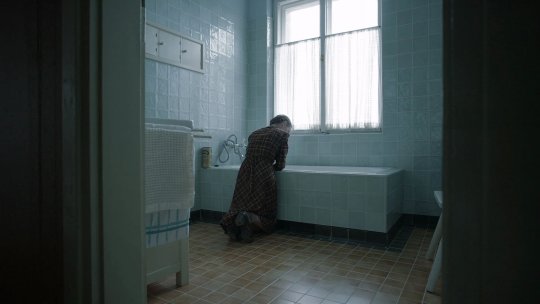


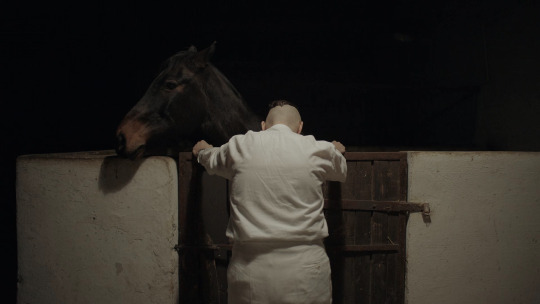
#the zone of interest#2023#jonathan glazer#sandra huller#christian friedel#history#auschwitz#world war 2#cinematography#movie screenshots#movie screengrabs#movie screencaps#movie frames#cinematography appreciation#movie#movies#escapism through film#the beauty of cinema#photoset#2020s cinema#2024 oscars#2023 cinema#oscars
155 notes
·
View notes
Text

On this day in 1945, the Soviet Red Army liberated Auschwitz concentration camp in occupied Poland, revealing to the world the horrors of Nazi occupation.
178 notes
·
View notes
Text
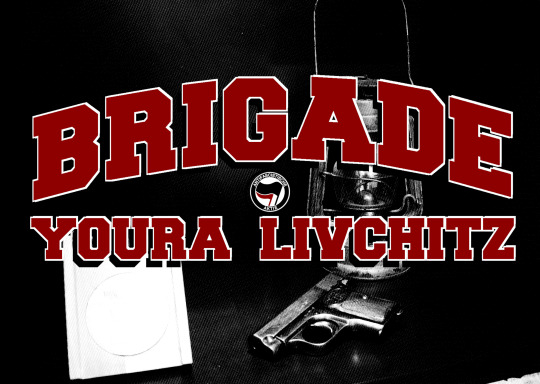
Youra Livchitza was one of the people who stopped the XXth transport out of Mechelen towards Auschwitz.
They were just three people, a red lantern, a pistol, boltcutters and 50.000 belgian franks to distribute among the prisoners.
Youra Livchitz, Robert Maistriau and Jean Franklemon stopped a train carrying mostly Jewish prisoners, and opened the carriages.
263 deportees managed to escape, 23 to 26 were shot on the spot, 92 were recaptured later, 118 people survived due to their action.
It's important to keep remembering that we can always make a difference.
https://nl.wikipedia.org/wiki/Twintigste_treinkonvooi
94 notes
·
View notes
Text




Palestinian citizens displaced from the city of Khan Yunis due to Israeli raids travel with their belongings on their vehicle roof to the city of Rafah, south of the Gaza Strip on January 22, 2024 in Rafah, Gaza. (Photo by Ahmad Hasaballah/Getty Images)
نزح مواطنون فلسطينيون من مدينة خان يونس بسبب الغارات الإسرائيلية يسافرون مع ممتلكاتهم على سطح مركبتهم إلى مدينة رفح جنوب قطاع غزة في 22 يناير 2024 في رفح بغزة.
#غزة#خانيونس#gaza#khan younis#i stand with palestine#palestine#news#ethnic cleansing#getty images#israel#war crimes#artwork#holocaust#Auschwitz#فلسطين#تمبلر#united nations#UNRWA#LOL#ART#artist#tumblr#free gaza#freedom#euronews#heart#free palestine#humor#funny#meme
127 notes
·
View notes
Text

110 notes
·
View notes
Text
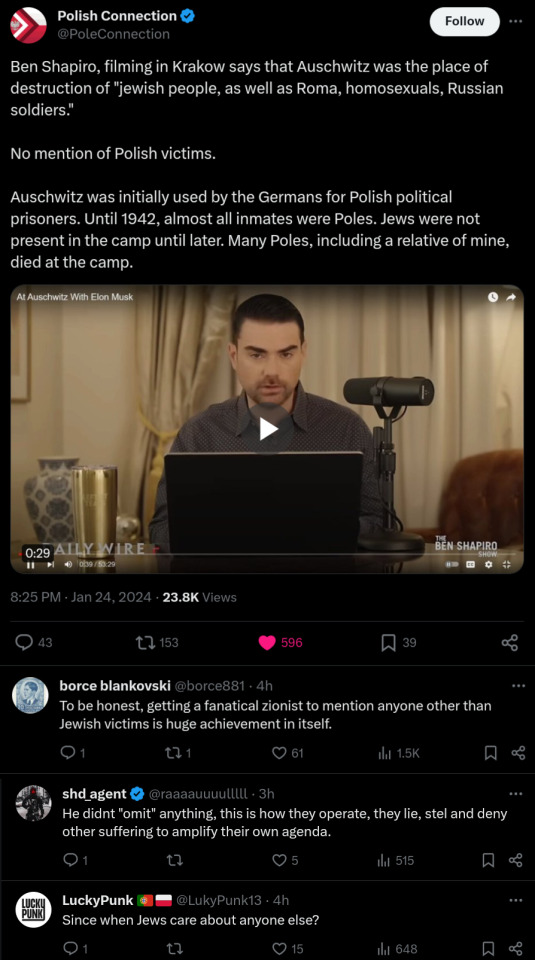
Damn, he even mentioned "Russian soldiers"... Russia was the second aggressor attacking Poland then...
Americans have really erased from the history books what Nazi Germany did to Poles and they are telling some Jewish version of history
#ben shapiro#auschwitz#warsaw uprising#ww2#wwii#second world war#world war 2#world war ii#ii wojna światowa#leftblr#leftism#leftist#politics#polish politics#american politics#poland#palestine#free palestine#free gaza#current events
127 notes
·
View notes
Text

January 27 marks Holocaust Remembrance Day.
This is a photograph of three year old Josef Schleifstein… taken on April 12, 1945.
This was the day that American soldiers came to liberate over 21,000 Jews at Buchenwald concentration camp… He is completely overwhelmed as someone gives him a sweet to suck on… He smiles uncertainly into the camera… and then begins to cry…
Josef… who was born in Poland on March 7, 1941… lived the first few years of his life moving from one Jewish ghetto to another as his family tried to survive the German occupation of Poland… In 1943… when Josef was two and a half years old…he and his parents were deported to Buchenwald concentration camp where his father was placed in the “line” for forced labor… his mother in another line to be sent to Bergen-Belsen concentration camp… and Josef was placed with the children and elderly to be killed… In the confusion of so many people Josef’s father grabbed him and put him in a large sack of tools he was carrying… with instructions to be very quiet…. For months Josef remained hidden and his existence was kept secret from all but a few sympathetic German guards…
After the liberation, Josef and his father went to Switzerland for medical treatment… They returned to Germany to find Josef’s mother and lived there until they all were able to emigrate to the United States in 1948.
We Remember
Via: HSA - Holocaust Social Archive
138 notes
·
View notes
Text

Exterior, Auschwitz, Poland, 1990 - by Judy Glickman Lauder, American
75 notes
·
View notes
Note
musk bring his toddler son for Auschwitz. this is sick to see him bring his son for piggyback to holocaust memorial tour as Disneyland. the children under 14 allowed visit Auschwitz
I was much more disgusted by how the first thing he said after touring Auschwitz was
yes X could have stopped the Holocaust.... he went an main charactered himself about the Holocaust after touring Auschwitz, what a turd.
which would be bad all on its own, if Twitter wasn't FLOODED with Nazis right now, FLOODED with holocaust denial and Nazism, he had the nerve to claim its better than other platforms.... well maybe TikTok the subbasement of Jew hate at the moment, but twitter's unhinged Jew bashing is something.
any ways I think its important to bring kids to these places and tell the story but maybe Joe Biden is right when he brought each of his grandkids there at 14, for sure Musk being his 3 year old human prop X was questionable at best and coming from Musk, inappropriate.
76 notes
·
View notes
Text

The villa of Commandant Höss: a "paradise" which shared a wall with Auschwitz.
ARCHITECTURE OF GENOCIDE: THE ZONE OF INTEREST (2023)
Before I saw this film, I'd assumed that it would illustrate the way architecture can be used to facilitate denial or self-deception. Like PARASITE (2019), in which one - in that case wholly fictional - family creates a lavish domestic retreat from which they can't see the overcrowding, poverty and suffering that surrounds them. But although Hedwig Höss speaks of planting vines to cover the wall they share with Auschwitz, there's no pretending this neighbour isn't there. The Höss's live in a pristine 1937 villa, with a manicured garden where they have parties and their children swim in a pool, and this juxtaposition is chilling. But they can still see the chimneys, and hear the screams, and nobody is denying what's next door.
This is one of the most horrifying movies I've seen, and that's due to the banality of the domestic scenes. We aren't watching a stereotypically deranged mass murderer, or even a psychopathic commandant at work inside the camp. Instead we see a comfortable house, a beautiful garden, two parents who love one another and their children. And who've somehow been able to assimilate the fact that millions are being murdered behind their garden wall.
The film is based loosely on a novel, but also on research into the lives of the real Höss's. A replica was built of their villa and garden, only metres from where the real home still stands. It's suggested that the real Rudolf and Hedwig considered themselves homesteaders, reclaiming rural territory for the 'master race', as was the Nazi ideal. In the film, Hedwig repeatedly emphasises the role of building and grounds as a status symbol. Their villa had been taken from its Polish owners and architecturally altered to fit the Höss's image. Most of the items inside would have been plundered from Jewish homes, and others, such as stools, and the wheelbarrow full of smaller seized items, would have been custom-made by prisoners. This isnt a home that is genteel in spite of the camp next door. On the contrary, everything about it, down to the fur coat on Hedwig's back, exists as a result of persecution and genocide.
The Zone was an exclusion area of over 40 sq. km around the camp, created after Poles and Jews were expelled from nearby villages. It's jarring how idyllic it appears in the film, with meadows, birdsong, a gently babbling river. While obviously not as horrifying as human apathy, the indifference of a place to the evil it houses is disconcerting, especially if you're in a profession like architecture or urban design, where places are thought to be somehow expressive of what occurs within them. We do see the horror occasionally seep beyond camp walls - a practiced scramble to leave sun loungers as crematoria smoke seeps into the garden, a wash of ash infiltrating the picturesque river.
It's likely that the filmmakers were using the extreme example of this family to remind us of our own ability to become apathetic and desensitised to the suffering of strangers, particularly when we feel our personal safety and comfort may be threatened. (Current campaigns to essentially criminalise poverty in the form of homelessness in certain cities, come to mind). Obviously the murder of millions is an evil on a completely different scale, and I have to believe that 99% of us wouldnt be capable of the Höss's actions, but it's a chilling and worthwhile reminder nonetheless.
62 notes
·
View notes